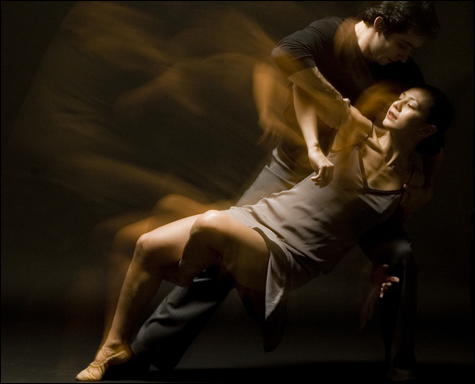
|
Hubbard Street Dance Chicago proved a worthy finale for Jacob’s Pillow Dance Festival’s 75th-anniversary season. Directed by Jim Vincent, HSDC is a well-trained and versatile troupe whose dancers are also beautiful performers of works from today’s best global choreographers. Many American modern-dance companies present only the works of their eponymous choreographer; HSDC allowed us to sample from an international menu. Still, five dances on one program would have been too much to digest if not for the quality of the works and the engaging and proficient elegance of the dancers. This program had an excess of visual similarities, mostly in lighting design and costuming.
The program opened with Twyla Tharp’s 1979 classic Baker’s Dozen, still lucky, still fresh. A dancer slithers into a pirouette and then pops out into a cartwheel, and might from there be pulled off stage in a most awkward position — crouched on heels — but with a catbird-seat smile. Some companies adopt a nonchalant mien when performing Tharp dances, and though that complements the shruggish slink and easygoing athleticism of her movement, HSDC’s joie de vivre shows Baker’s Dozen from another angle. The jokes are still there — the exiting and entering shenanigans, the duets complicated into trios (nonplussing the men but tickling the women) — and so are the out-of-nowhere dance sequences, such as the man’s thigh-slapping, finger-snapping, torso-gyrating solo. Baker’s Dozen proved the HSDC dancers to be fluent in several genres. (Their least effective work was in the closer, Nacho Duato’s Gnawa, a disappointment to this huge Duato fan — the quiet central duet aside, it settled too easily.)
It turns out these dancers can convey emotions, too. Susan Marshall’s Kiss is a bleak duet that uses harnesses as a metaphor for emotional imprisonment. As Cheryl Mann and Tobin Del Cuore hang in those harnesses, which are suspended from the rafters, they spin away from each other, then sputter and grasp toward each other. When they do connect, they cling, sometimes one draped over the other, sometimes their lines twining round and round; the inevitable separation is either surreal, with Mann dreamily unwinding away from Del Cuore, her head and upper torso swooning back, or stark, the harnesses cruelly underscoring the futility of a hopeful outcome. Only once does it seem that the two will break free: side by side, they take several huge running strides on an upstage diagonal, push off, and leap, soaring around to face the audience again, legs arced into matching front and back attitudes. The pair’s interpretation is spot on; too much angst and Kiss could become a parody of young lust.
Lickety-Split is an interesting companion piece to Kiss, with its rather sweet portrayal of youth. Choreographer and company member Alejandro Cerrudo maintains the mood — neither cloying nor overly silly — with his own evocative lighting concept, creating a shadowy, intimate space for the six dancers, and he takes advantage of the company’s fluid, fearless partnering. (This adventurousness was evident throughout: the transition from, say, a modernish fall and recovery into a balletic pirouette didn’t have that air of artifice that puts the ballet steps in quotation marks, and the partnering sequences were more surprising because the preparations weren’t overt — even the acrobatics looked like . . . dancing.) The duets they ultimately break off into flow into the whole, and even the eccentric gestures — sometimes goofy, sometimes oddly moving — that Cerrudo weaves in feel just right